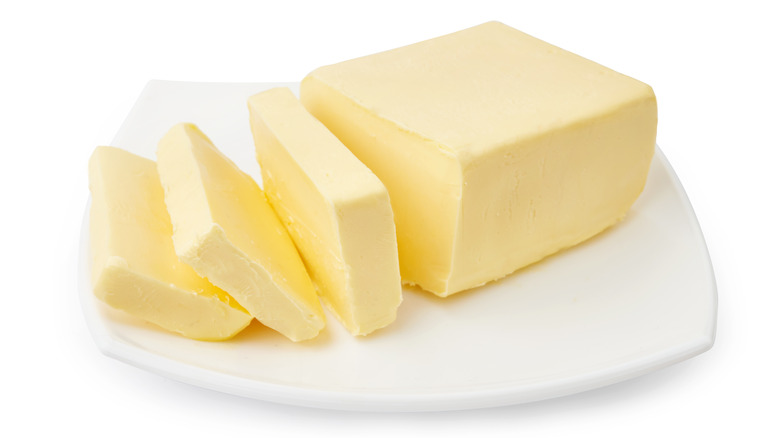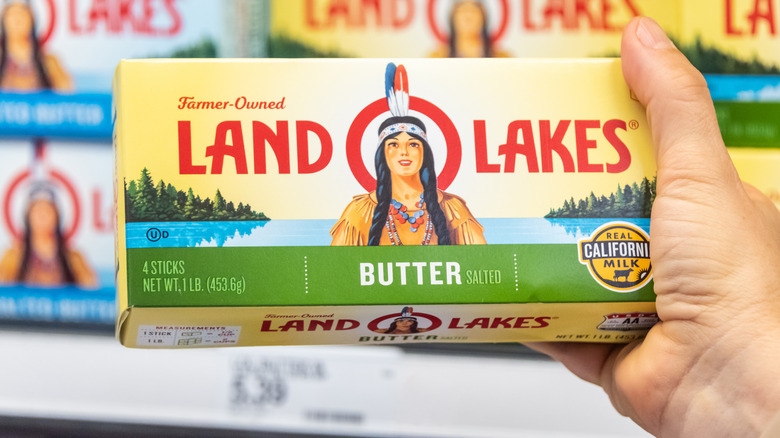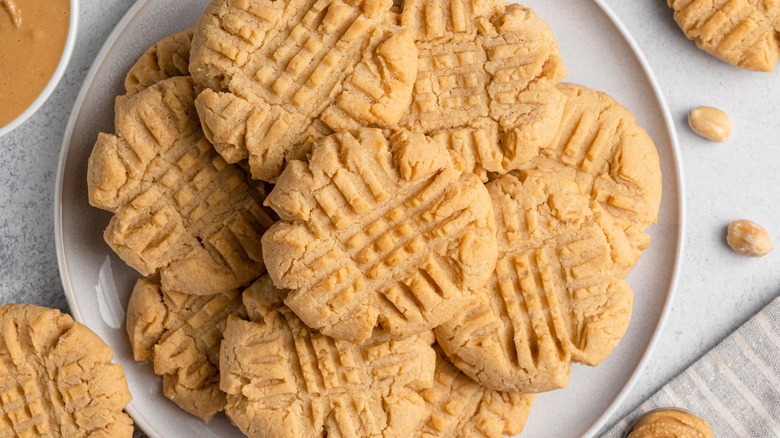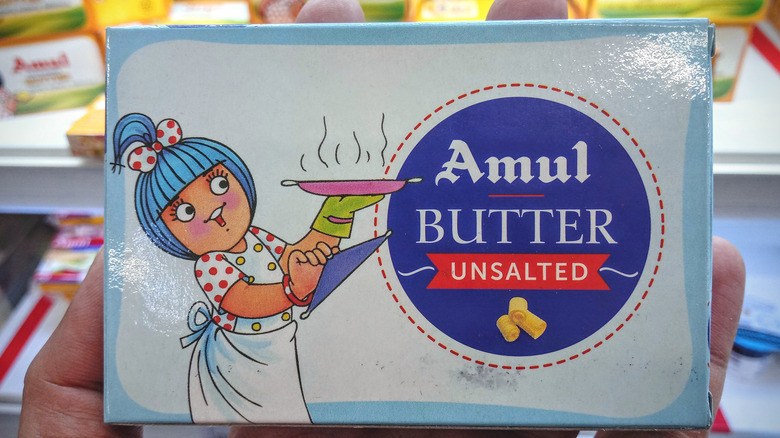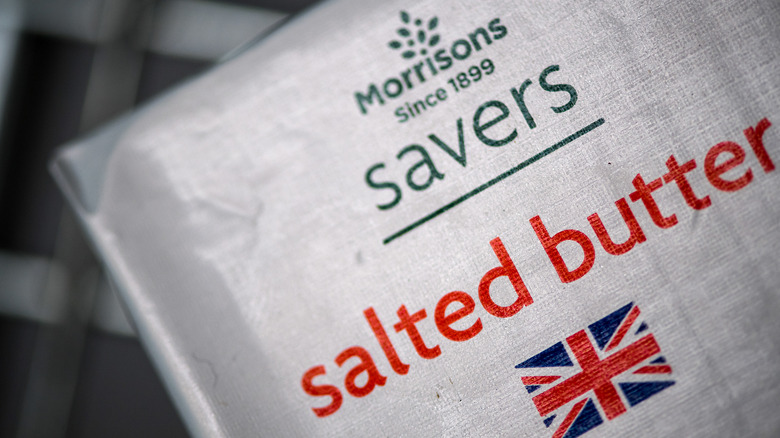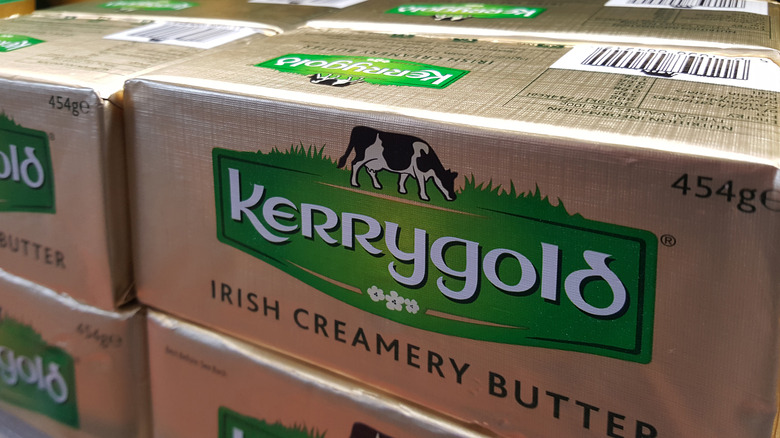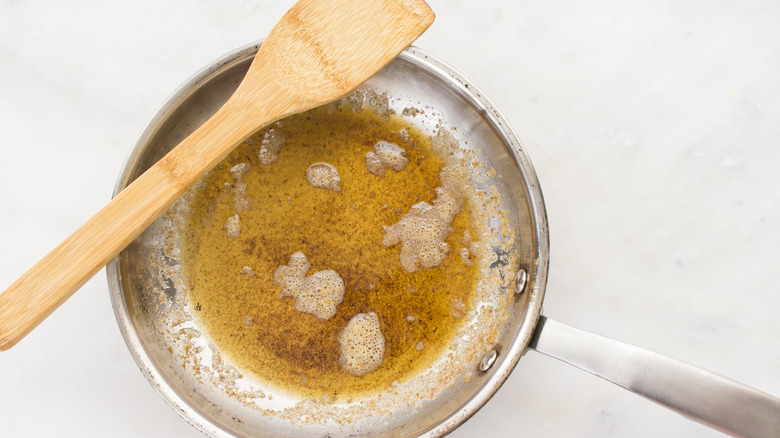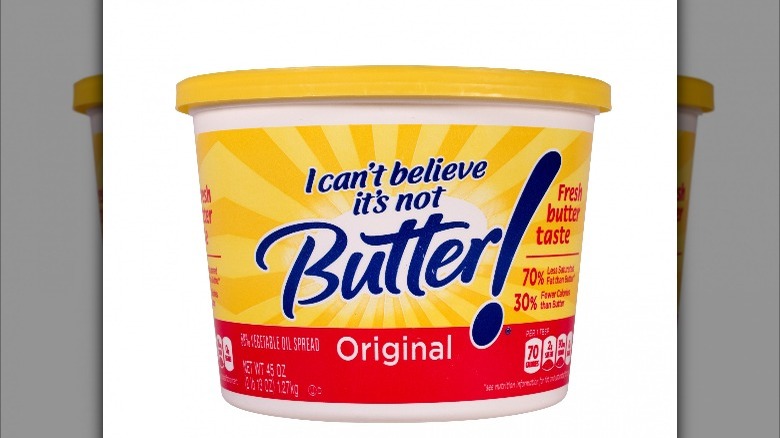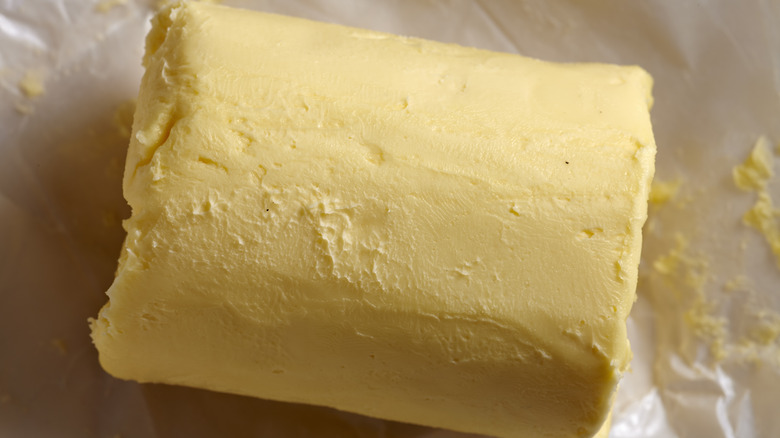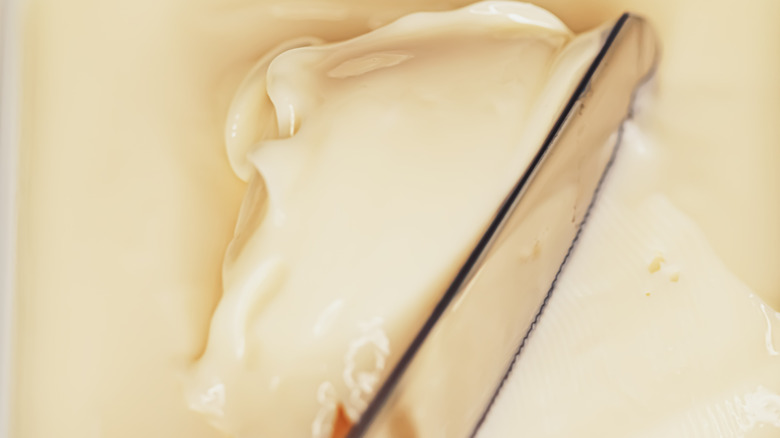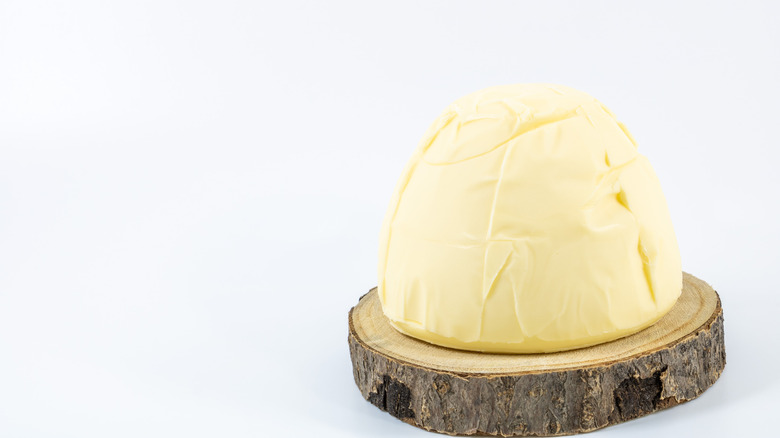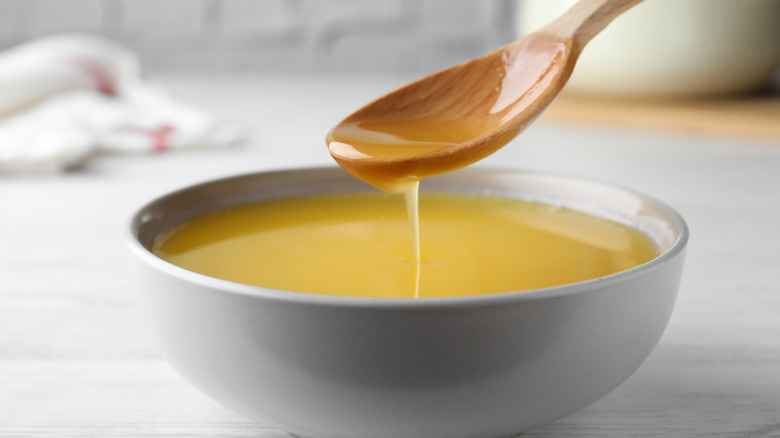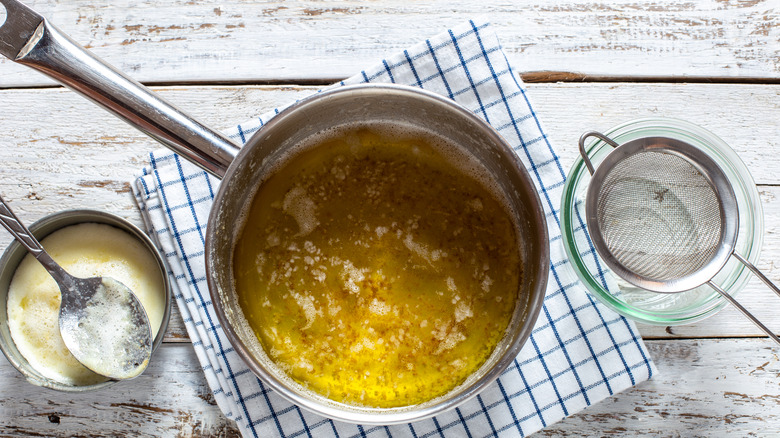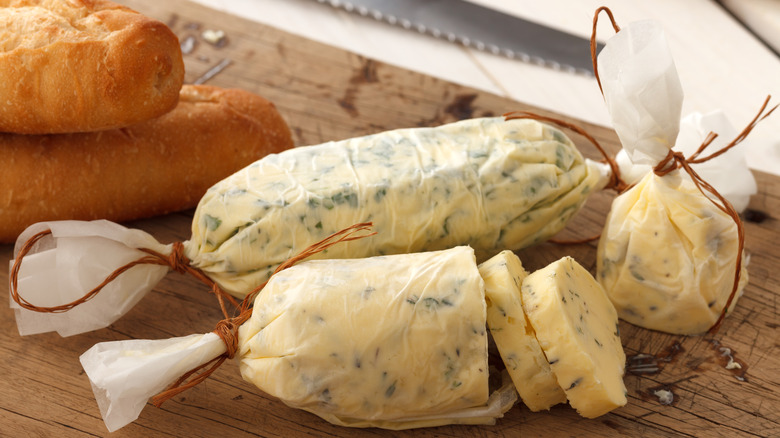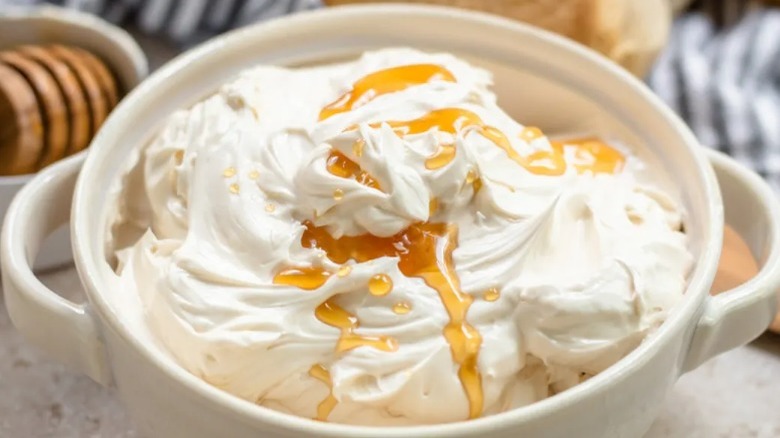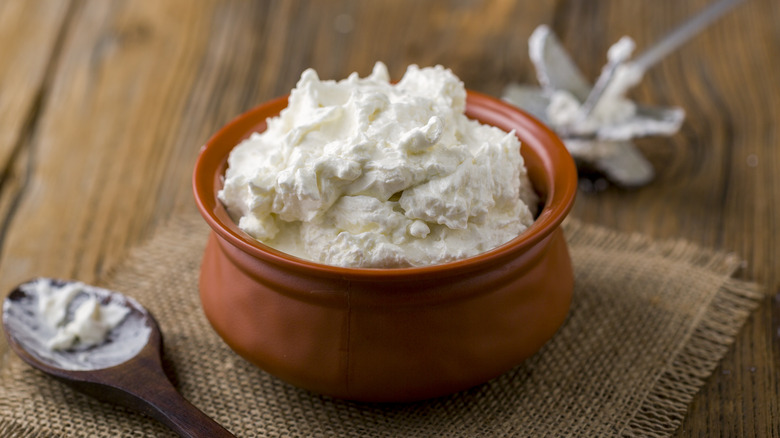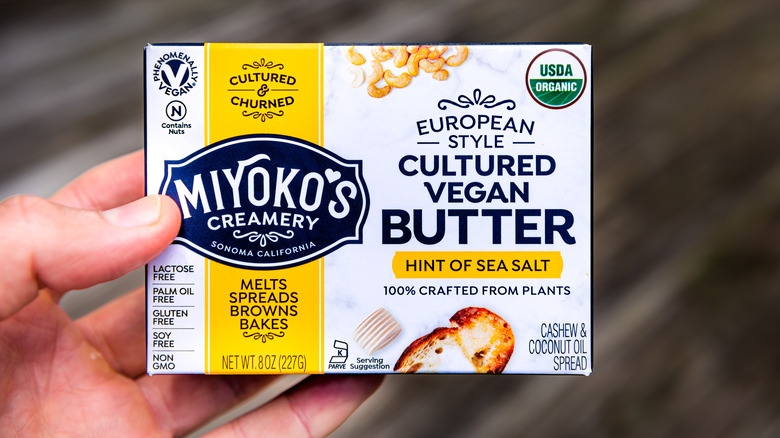18 Types Of Butter And The Best Ways To Use Them
We may receive a commission on purchases made from links.
Many of us know that it really doesn't get much better than butter. The rich dairy product adds richness and comfort wherever it goes, from melting atop a stack of pancakes to dripping down a mountain of mashed potatoes to being a vital ingredient in a universe of baked goods. The numbers don't lie about how much and how often we use butter: America's overall consumption of butter clocks in at around 6.3 pounds per capita (via Statista).
While we love butter, and we love it well, the history of butter stretches well beyond and before the United States. One food historian theorized that butter was most likely first churned in Neolithic Africa around 8,000 BCE (via NPR). The historian theorizes that butter was most likely made accidentally: Shepherds probably unknowingly churned curdled milk as they traveled over long expanses of land.
While it to this day remains unclear when ancient peoples began cultivating butter purposefully, there's no argument that butter went on to become a beloved staple within many cultures. After originating in Africa, butter was introduced to the Middle East and to Europe. Of course, butter then moved from Europe over to the U.S, and there are several different varieties of this ancient treat!
American
Considering how much butter Americans consume, it's should come as no surprise that there's a distinct American butter. As Martha Stewart clarifies, each country has stipulations as to how much fat should go into butter. American butter has around 80% butterfat to meet USDA standards. While this may sound like a lot, it's actually a bit less than other kinds of butter. American butter is a bit blander, harder, and paler as compared to European butter.
For many households, American butter tends to be the default. Big-name brands like Land O'Lakes, though rebranded, persist as a household staple in modern times. We already tend to use American butter in our everyday cooking.
The French American Cultural Foundation recommends using American butter for some baked goods like brownies and chocolate chip cookies and savory dishes like gratin. It's less important to differentiate between American and European butter. It's even more important to differentiate use between, say, unsalted and salted American butter.
European
European butter is just about the opposite of American butter, and to some, it may even sound better. It's brighter, richer, and softer, according to Martha Stewart. This is partially due to the fact that European butter usually contains more butterfat than American butter, usually around 82 to 90%, due to European Union regulations.
Those who are excited to enjoy European butter may be put off because it's much tangier than its American counterpart. European butter may taste much more like sour cream or yogurt than American butter. This unique flavor profile is due to the active cultures or fermentation processes that are used to make European butter.
Arguably one of the cuisines that best utilizes butter is the French cuisine, and the French American Cultural Foundation recommends integrating European butter for a flavor boost into dishes such as morning toast and shortbread cookies, as well as butter-based sauces.
European butter, while expensive compared to other varieties, is a delight worth investing in. Martha Stewart notes that there are plenty of varieties of European butter in specialty and grocery stores, and there are some stateside creameries, like Daphne Creamery of Wisconsin, that have started to churn out this beautiful style of butter.
Unsalted
Both American and European butter can be found in unsalted and salted forms. While this may seem like a minute difference, the two forms of butter are used for very different purposes. Butter may not be synonymous with good health for many people, but unsalted butter carries some major health benefits with it. According to WebMD, butter contains a medley of vitamins and minerals, including, of course, calcium.
The real trick to enjoying the flavor and potential benefits of butter is to enjoy it in moderation. One part of enjoying butter in moderation also includes avoiding the salt that butter often contains. Unsalted butter, by its definition, contains no salt, and it can help those looking to cut down on their day-to-day salt intake.
Unsalted butter is essentially a sweet cream. The Food Network explains that both salted and unsalted butter can essentially be used interchangeably. The network does, however, advise not to use salted butter when unsalted butter is called for in a recipe.
The test kitchen used to make the recipe most likely already experimented with and found the perfect salt and butter ratio to make the recipe truly shine. Land O'Lakes notes that the sweet butter is best suited for flavor-heavy recipes like butter cookies and pound cakes. The site concludes that unsalted butter tends to be a more subtle variety that brings out the medley of flavors in the recipe.
Salted
Salted butter is, of course, the salty counterpart to all kinds of butter. According to The Greatist, salted butter usually contains around 90 to 100 milligrams of sodium, though some varieties contain as little as 45 mg.
Salted butter has certain benefits: For one, the added salt in salted butter gives it a longer shelf life than its unsalted counterpart, according to Southern Living. After all, salt is a preservative! The salt also allows the butter to be frozen for months on end.
Salted butter does come with some drawbacks, too, including the fact that because the salt is already added to the butter's formula, it can be hard to measure and control how much butter should actually go into the recipe. Thus, it can be difficult to use salted butter without overpowering baking recipes. After all, there is nothing worse than laboring on a recipe for hours only to be disappointed upon the first bite!
So, it may come as no surprise that salted butter really shines in recipes that don't need a lot of precision. Salted butter really works well as a topping porridge, as a spread on toast, and as a base for scrambling eggs, sautéing vegetables, and marinating pork chops.
Irish
European butter is a large classification of butter, but it's very useful to cast a curious eye onto the specificities of Irish butter. As Martha Stewart points out, it's one of the more widely available types of European butter in the United States. Irish butter, according to Real Simple, only contains around 82% butterfat which is comparably lower than other European butter. But make no mistake, Irish butter is some of the richest and creamiest types of butter around.
What makes Irish butter unique, however, is the country itself! Ireland is a country with lush pastures that are rich in beta-carotene. The unique geography of the country leads to truly unique butter with an unmistakable color and slight Earthy undertones. While Irish butter is a European butter, there is no other European butter quite like it.
It's not only the dairy that makes Irish butter one of a kind; it's also the churning technique and the cows that are used to produce it. Unlike other European kinds of butter, Irish butter is traditionally salted. Irish butter has long been cherished for pastry making by both professional and amateur pâtissiers, but its rich flavor does just as well when it's simply spread out on a nice slice of bread.
Brown
Brown butter is truly the unsung hero and underdog of the butter world. Those who are in the know, like the people over at Martha Stewart, are quick to point out that this butter is often referred to as the liquid gold of the butter world.
Brown butter is actually more of a sauce. It's made by simmering a full stick of unsalted butter in a pan quickly until it foams and solidifies into a dark brown mass. This process results in a highly aromatic butter with a richly sweet and savory toffee-like flavor, as described by Taste Cooking.
While it may seem unnecessary to take butter and make it richer, it doesn't take much to recognize the absolute heaven that is brown butter. Martha Stewart clarifies that while one might think this is a butter that solely resides on the dessert table, it actually works well as both a sweet and savory ingredient.
Brown butter can be used in dishes as varied as Dutch babies, risottos, crinkle cookies, salmon salads, as well as other excellent brown butter-infused dishes. Just be careful: Once you start using brown butter, you may find yourself looking for any excuse to whip it up!
Grass-fed / Organic
Americans have increasingly started incorporating organic foods into their diets for a multitude of reasons. Organic butter can be understood as a type of butter sourced from farms that allow the cows to feed on organic fields (via Healthy Food).
Thus, organic and grass-fed butter will often be referred to interchangeably. In order to absolutely know whether or not the butter is organic, make sure to look for the USDA organic label.
There are different contexts and reasons for choosing organic ingredients. However, there is absolutely no change in the composition of organic butter. Though that being said, some studies have found that grass-fed butter contains more omega-3 and fatty acids in comparison to non-organic kinds of butter.
Nonetheless, it will still contain just as much fat and calories! Thus, it's best to exercise caution and enjoy it in moderation. Organic American types of butter, both salted and unsalted, can be used in the same way as their non-organic counterparts.
Margarine
Margarine has become a household name. But if it isn't butter, then what is it exactly? Recipe Tips defines margarine as a vegetable-fat-based spread that closely mimics the general taste and smell of butter. Though do beware, if margarine is labeled as a spread, it typically contains less than 80% fat, which can lead to a milder flavor (via Reader's Digest). Interestingly, margarine isn't a product of the modern world.
Reader's Digest credits the Napoleonic Wars as the driving factor in the creation of butter. It's recorded that Napoleon was seeking to feed his troops on a budget, and he turned to the French people to develop a way to do so. By 1869, margarine had come into existence. Ultimately, margarine didn't prove to be just a wartime staple. It wasn't just the French people but also the world that came to love the cheap butter alternative.
When it comes to cooking and baking, both sources note that margarine can be a good substitute for butter. It produces similar results to dairy-based butter, though there are a few bonuses depending on the chef's desires. The oil in margarine makes it heat tolerable and less likely to burn: When baking, this could mean thicker cookies and flaky pie crusts. Of course, the oil allows for margarine to work exceptionally well as a spread.
Amish
In the landscape of the different types of butter that exist in the United States, Amish butter perhaps has not received its dues yet. For those unfamiliar with the heavenly good, it's good to get to know a bit about it before going the fully Monty.
As Taste of Home clarifies, the name doesn't necessarily mean that the butter has been hand churned by the Amish, but rather that it is definitely sourced from Amish milk. Nonetheless, if you opt for this one, you're in store for high-quality butter, regardless of whether it has been made with or without technology.
Amish butter is much richer than typical American butter, as it's actually a churned cream. This means a much higher butterfat content which will lead to a lovely and flavorful butter. There's an aesthetic element to Amish butter: It's often sold in parchment paper, and if one has the chance to buy it at the Amish market, one will find it rolled into different shapes, including full-blown rolls, as per the tradition.
For those who have found themselves tragically outside of Amish country, give into FOMO and check out Minerva Dairy on Goldbelly. The Ohio dairy, which claims to be the oldest in the country, promises quite literally to deliver its butter to every corner of the country. This butter, with its 85% butterfat, is surely a rich endeavor to pursue.
Spreadable
Spreadable butter is a point of passion for many: Who really wants to have a clumpy lumpy mess of butter clogging up the flow of the morning toast? Spreadable butter is such an important point that the Canadian internet rose up in 2021 to investigate exactly why it was that butter stopped spreading so easily at room temperature (via NPR).
Cheekily named "Buttergate," the scandal turned attention to the use of the ever-controversial palm oil in Canadian butter and whipped up a discourse on whether or not it was ethical or delicious to use it. Needless to say, spreadable butter is something that is on people's minds, even when it's not on their plates.
Spreadable butter is butter that doesn't need to be heated to spread. It was first developed in another member of the Commonwealth, New Zealand, in 1991. While one might think that spreadable butter is synonymous with margarine or oil-based kinds of butter, spreadable butter is completely dairy-based, according to Cook's Info.
The science behind the spread is pretty impressive: Butter is heated, and as it cools, the butterfat that doesn't resolidify is collected. This liquid butterfat is mixed with skim milk. This creates a spreadable butter with around 80-82 percent butterfat and never needs to be softened. Spreadable butter is best used as just that: A butter spread that can be layered atop bread, rolls, and crackers, aplenty.
Cultured
Cultured butter can be an intense experience: This variety typically tastes very intense and tangy, but its flavor profile can vary greatly beyond that, according to Culture Cheese Magazine. This is because the butter is cultivated from bacteria cultures (hence the name "cultured butter).
The bacteria is created through slightly soured milk, as noted by Will Studd, which will then be churned into the cream used to make the butter. In that sense, cultured butter can also be understood as a sort of "fermented" butter.
The use of slightly soured milk results in an intense smell and taste, according to the latter source. The rest of the butter's intense flavor profile largely depends on the specific bacteria that develop in the milk, which in turn depends on the sort of feed the dairy cows were fed before producing milk. The second source notes that while this method of using soured milk has all but disappeared, French Normandy butter and Charentes-Poitou butter provide welcome exceptions.
The site praises the seasonality of the cultured butter: While they may be unpredictable in flavor, they will always reflect the goodness of what the cows are eating. Various types of cultured butter have long been cherished by French chefs, who use them to add an extremely rich element to their cooking.
Clarified
While clarified butter may be a confusing and unfamiliar name, as observed by Food Network, many of us have had clarified butter without even knowing it! This form of butter is a darling, especially in steak houses where it is used to pan-sear steaks.
It can be a bit of a challenge to understand what exactly clarified butter is: It is butter that does not contain milk or water. When raised to a boiling point, the butter's water will evaporate, and the butter (with all its proteins and sugars) will then separate further to the bottom of the pot.
Clarified butter is extremely rich, as it's essentially a collection of fat. The site details that this butter gives pan-seared steaks a much more flavorful twist than, say, oil. And, because clarified butter has a higher smoke point than other kinds of butter, it can be used as an oil.
Clarified butter can be used as a modifier for finicky hollandaise sauces. For those looking to clarify both their lives and their butter, don't fret: There are plenty of ways to do so by hand. It's even possible to clarify butter in the microwave!
Ghee
Ghee and clarified butter are often considered to be the same, but it's important to make a distinction. As Masterclass notes, ghee is one form of clarified butter. Like clarified butter, ghee is heated so that the water and protein separate. However, ghee cooks for a little bit longer so that the proteins turn brown. Once the proteins have reached this state, and the butter takes on a roasted aroma, the butter is then strained, and its fats are separated from the proteins.
The result is an extremely decadent ingredient. Like clarified butter, ghee has a high smoke point and rich flavor, and it will not spoil as quickly as other butter. On the other hand, ghee has an intense smoky aroma.
Both Masterclass and Farmer's Almanac note that ghee is extremely popular in Indian and South Asian cuisine. Ghee is also used in ayurvedic medicine! Even if you aren't turning to it to heal your next ailment, it can certainly be used to enrich a good sauté. Both sources also note that ghee makes a wonderful butter for those who are lactose intolerant as all the dairy has been boiled out.
Compound
As the name implies, compound butter is made by mixing (or compounding) butter at home. Web Restaurant Store observes that compound butter is made by meshing room-temperature unsalted butter with different herbs, spices, and even jam, to flavor it up. Simply put, compound butter is a type of butter that is made by combining it with just about anything else.
The store praises this style of butter as being one that can really add bold flavor to whichever dish it's added to. But really, that doesn't narrow it down anymore! Compound butter can adorn steaks and turkeys, or it can be spread out on baked goods or atop a waffle. The world is truly your oyster when it comes to compound butter.
While there are plenty of compound different compound butter that can be found in supermarkets and artisanal stores, it's entirely possible to make your own compound butter at home. Really the most crucial part of making compound butter is having the right tools, such as a food processor or mixer. In terms of actually consuming this butter, you'll simply have to follow your heart and stomach and see where they take you.
Whipped
Whipped butter is a very spreadable form of butter. As one might guess from the name, this type of butter is made by whipping, rather than churning, cream into butter (via The Food Network). The intense whipping process leads to an airy yet solid butter that is a bit lighter and easier to work with than other forms of butter. Back in the day, this type of butter had to be hand-whipped, but nowadays, it can easily be purchased in stores.
Breakstone's Whipped Butter is perhaps among the most important of all the whipped butter brands. The brand was created in the late 19th century by two brothers who had recently come to the States, as noted by My Jewish Learning.
Breakstone's provided pre-made whipped butter at a time when women were primarily still hand-churning their butter, which helped make the seemingly endless demands of the kitchen a little bit more navigable. Breakstone's also provided a kosher butter that's still quite meaningful to the Jewish community and as a Passover staple.
Whipped butter is made to be spread, and it best spends its time atop a slice of bread. Because of its light texture yet rich flavor whipped butter pairs obscenely well with different flavor combinations. Among the universe of delicious whipped butter creations, whipped honey butter can make a wonderful Springtime spread for any bread.
Sweet cream
Unsalted butter is often referred to as sweet butter because it's so often used for cooking (via Challenge Butter). This shouldn't, however, be confused, or used interchangeably with sweet cream butter. For one, cream butter does use salt, unlike its unsalted counterpart, as outlined by MasterClass.
This butter uses heavy cream made from pasteurized milk. The butter is sold widely across the U.S., and MasterClass clarifies that sometimes sweet cream butter is referred to simply as American butter.
Sweet cream butter is extremely white and airy: It almost resembles a bowl of whipped cream. This butter variety has a low smoke point, and it doesn't react well to extremely high temperatures. It's favored by chefs and bakers due to its sweet nature and its lack of salt.
Similar to unsalted butter, sweet cream butter has a shorter shelf life due to the fact that it doesn't contain salt. One should really only keep the butter five months past its manufacturing date.
Light
The "light" in light butter doesn't refer to this butter's appearance, but rather, its content. As explained by Cook's Info, light butter is really just butter that has considerably less butterfat than the average butter. As the info site observes, in the U.S., light butter has just about half the amount of butter fat that normal butter does. In order to create light butter, the product's fat is replaced with water and air. This process is extremely complicated, which means that just about all light butter needs to be made industrially.
Light butter is a great alternative for those who are being calorie conscious but would still like to indulge a bit in the joys of the buttery world. This is perhaps best evidenced by Smart Balance, a brand that recently faced backlash for even daring to change its OG butter flavor.
While light butter is great for spreading, it doesn't do well on or around the stove. The butter has an extremely low-smoke point and is prone to burning. So, it's safe to say that you shouldn't use this butter for baking a cake. But as Cook's Info diplomatically points out, light butter can slowly be heated up and drizzled on popcorn if you're in the snacking mood.
Plant-based
It's no secret that plant-based diets are becoming more and more mainstream. Fittingly, more plant-based products are also hitting the markets! So much so that in 2020, Forbes even claimed that plant-based butter was "taking over" the dairy aisle.
While the article points to health concerns and changing diets as reasons for why different varieties of plant-based butter are popping up more and more often, it also pointed to supply chain changes during the COVID-19 pandemic as an opportunity for the new product to navigate a new market.
While margarine can be technically understood as a plant-based butter, there are some distinctions to be made! New-wave plant butter tends to utilize more "high-quality" oils like avocado and olive oil (via Pure Wow). These results are not only described as tastier but also healthier some types of plant-based butter don't include the more detrimental vegetable oil. So, these types of plant-based butter of the 2020s can be understood as an improved type of margarine.
However, Pure Wow warns not to conflate this with plant-based oils being healthy! The site notes that these kinds of butter are just as fatty as regular butter and should be enjoyed in moderation. Because plant-based butter tends to contain a variety of oils, its exact uses depend on the exact oil used. Generally, these vegan-friendly butter can be used for general cooking and baking and as a yummy spread.
